Notes on a Morbic Build in New Zealand.
12




12
|
Administrator
|
Well done Nigel.
Another Morbic is born. It really does LOOK like a boat, and almost ready to float like a boat. When will it get its bottom wet? PW |
Re: Notes on a Morbic Build in New Zealand.
|
In reply to this post by Nigel McC
That looks really gorgeous!!
|
Re: Notes on a Morbic Build in New Zealand.
|
In reply to this post by Nigel McC
Hi,
I also ordered from Classic Marine the rudder fittings, mast traveller, and rowlocks, back in November, before even receiving the plywood, and I’m still waiting for the materials to be delivered. It seems they have some problems with the foundry shop and it will discontinue the supply of series one. I have been told mine was the last order with series one parts. But I’m still waiting… Regards, Carlos |
|
In reply to this post by Nigel McC
Out of interest, I usually attach the rowlocks with a cord, one end clipped to a saddle that is screwed underthe gunwales. At $80 each, you can't afford to lose a rowlock overboard.
But when I came to fit the saddles, there was no room between the seat top and the bottom of the gunwale to drill and fit the screws. Solution, remove the rowlock plates, chisel out a recess under the the plate, and drill through the gunwale, then tuck in the cord with a stopper not, and replace the the plates! Looks neat, but of course the rowlocks will be permanently tied in, which might be inconvenient when sailing or rowing, so I might cut the cord and tie a bowline to accept a clip. 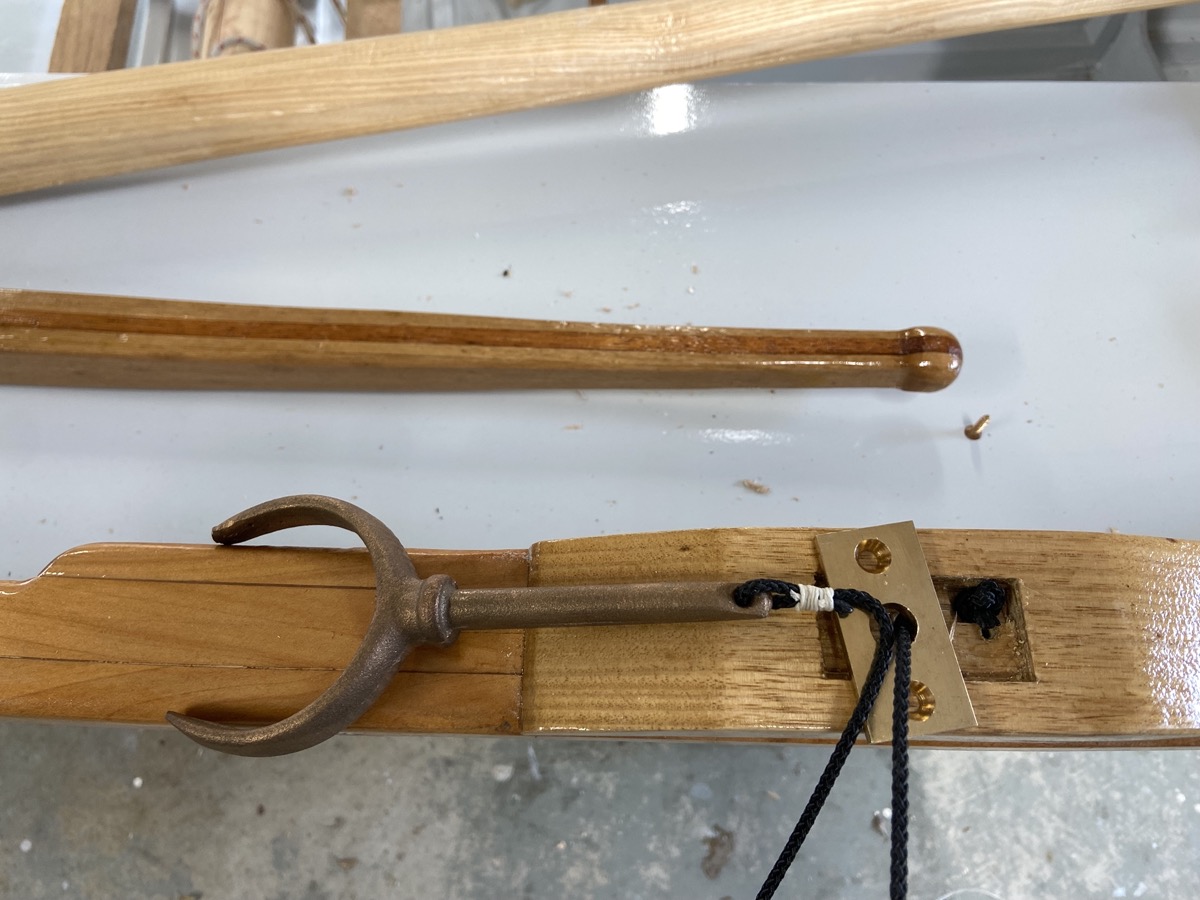
|
|
Administrator
|
Interesting stuff Nigel. Thanks
See what you think of this option, (applied on Proteus). In opperation, you slide the toggle away from the knot, then cock it over (in the right direction) to lie close alongside the cord. The flats enable the combined diameter to slide through the bush. 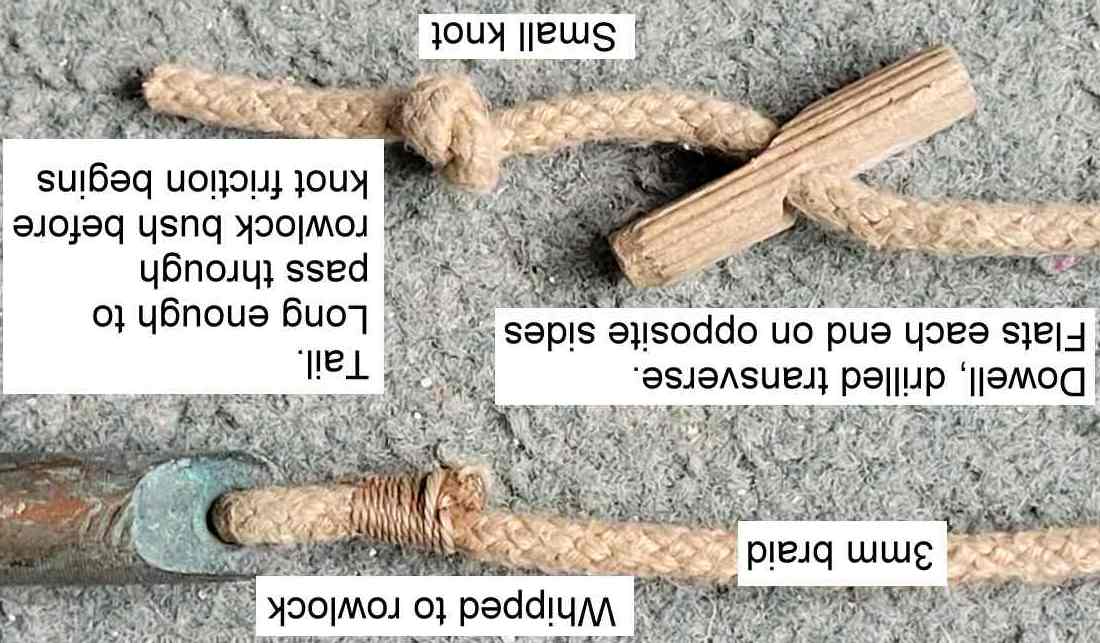
|
|
In reply to this post by Nigel McC
First fine weather for what seems weeks. We had 100 mm rain last Tuesday/Wednesday, so with blue skies, off to Hamilton Lake for a trial launch.
Great fun. when the breeze fills, Taranui takes off. Lots of tweaks to do. Secure the boom leech clew, improve the aft reefing system, fit a longer tiller with an extension so I can get the weight forward (too bow up on the first trial. But we have a Morbic, Here are some photos - I have no idea why the first is rotated through 90 degrees. 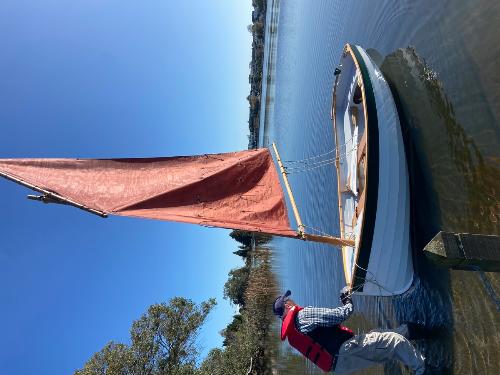 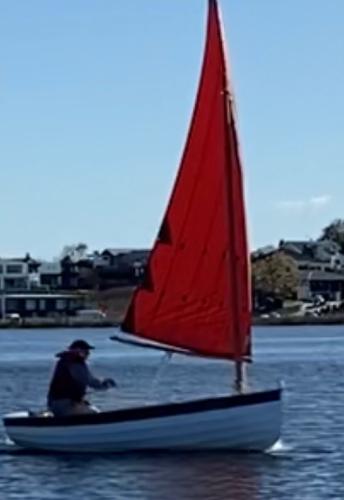 As well, out of interest. I cannot find a someone to forge Vivier;'s design of yard haul. So I spliced loop round the yard, and tied a cirle of parrel beads (wooden beads from a $2 shop) and a stainless S hook. Works fine. 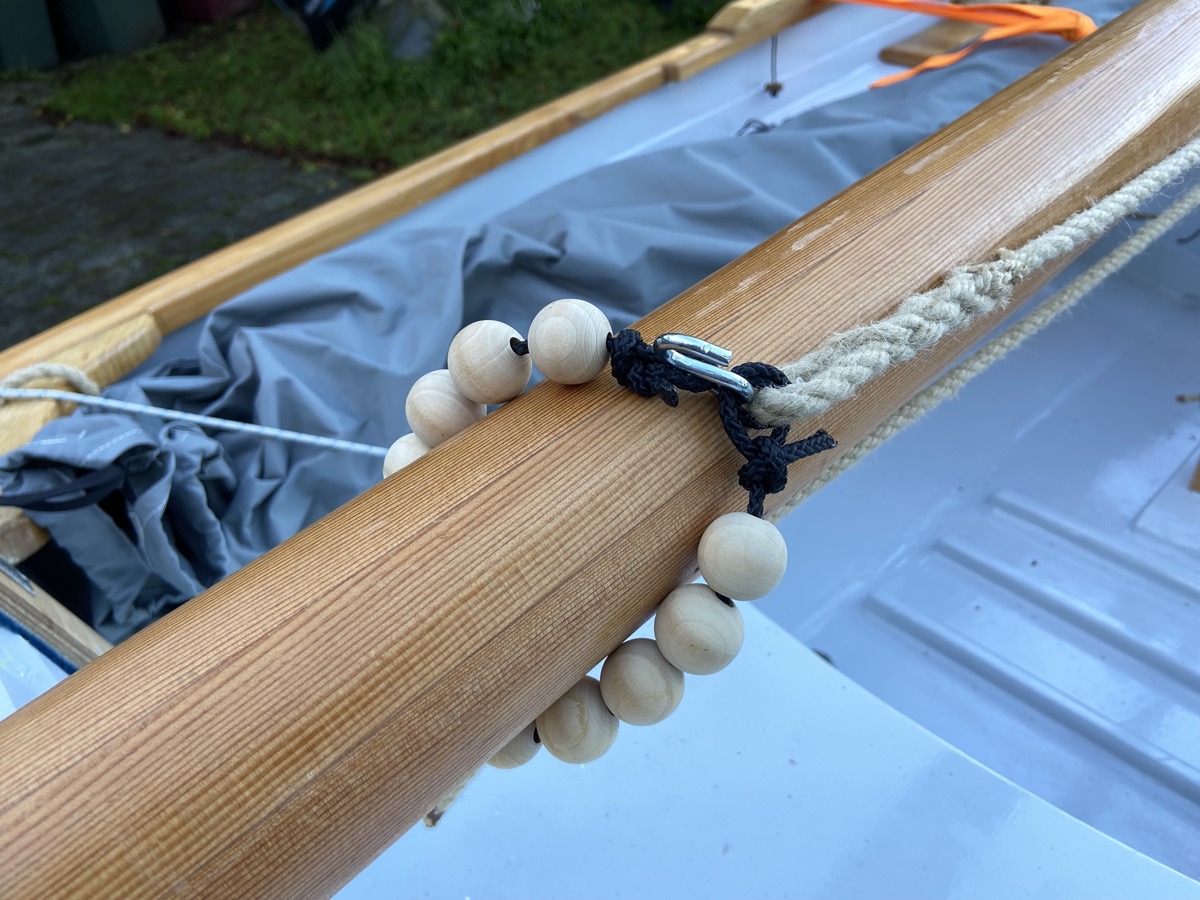
|
Re: Notes on a Morbic Build in New Zealand.
|
Congratulations Nigel, she looks great. A fine effort.
Graham Neil
https://port-na-storm.blogspot.com/
|
|
Administrator
|
In reply to this post by Nigel McC
Hi Nigel.
(Slow to respond to your posting because Proteus, Robin and I are at Semaine de Golfe du Morbihan.) So, another Morbic is born. Looks as beautiful as any. Well done. Intrigued by the parrell beads idea. Will be interested to hear how you get on with it. We've been using the Michael Storer system for the main halyard. We call it the "megga-bleater". The end of the halyard has an eye spliced to slip over the front end of the spar. The halyard passes from the masthead sheave, through an eye attached to the spar (between a third and half way back?), around the starboard side of the mast and onto the end of the spar. Smooth and silent in use. Re. Tiller extension. We find there is enough weather helm to use a short length of cord for the purpose - Pic attached. = Light, simple, robust. (& cheap!) The cord must be not quite long enough to reach the deck (so you can't tread on it!) 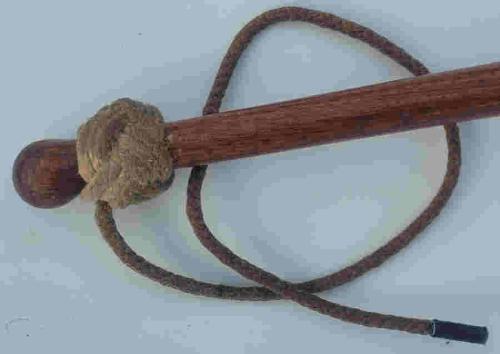
|
|
In reply to this post by Nigel McC
Out of interest, my first proper sail yesterday afternoon, on Lake Ngaroto – a peat lake 30km south of Hamilton. About 10 knots gusting 15 at first, rising to 15 gusting 20 before dying away late afternoon. Fabulous sailing punctuated by moments of high anxiety. I had an interesting time reefing out in the middle of the lake.
Two questions: Reefing systems; I fitted lazy jacks but I'm beginning to think they may be more a hindrance than a help. I ended up removing them mid-lake. I modelled the reefing system on the Goat Island Skiff arrangement; a pre-tied loop from the luff reefing point to catch round the fore end of the boom, and a clip on the outhaul to catch a second loop on the leech. Except that trying to catch the loop in the outhaul clip, with the boom in lazy jacks swinging around, whilst standing in the boat in a 15-20 knot gust was not easy. It might be easier to drop the entire rig into the boat, and reef sitting down, rather than struggling to balance against a fairly boisterous chop. What are other boats' experiences? Second, I note that Vivier's drawings belay the main sheet to the middle of the boom, through a three part tackle to a cleat, and most boats appear to follow this arrangement. An alternative is to belay the the sheet at the aft end of the boom, through a traveller at the transom, back to the boom, and forward through two blocks down to a centre mounted cleat. That would give greater purchase to the leech at the expense of sheet length. I note the shape of the sail in the stronger wind was very twisted, and I found the central tackle system couldn't flatten the leech as much as I would like, so I'm getting too much power up the top of the sail. Is anyone else using a transom traveller arrangement? No photos, I was too busy keeping Taranui upright. I don't want to go swimming at this time of year. |
|
I’ve belatedly noted an earlier discussion on main sheets .. most of you seem to be using central sheeting. I might try both and see what happens to the sail shape. I did see the small boats monthly video of a morbic 11 using a transom traveller
https://smallboatsmonthly.com/article/morbic-ii/ |
Re: Notes on a Morbic Build in New Zealand.
|
Hi Nigel,
I have built Morbic 113 in 2021 and use transom sheeting... and its fine. My 'traveller' is simply a length of re-purposed main sheet secured in each of the transom knee holes. I keep it fairly tight over the tiller and it gives me a good set of the main. Happy sailing. Peter |
|
Administrator
|
In reply to this post by Nigel McC
Hi Nigel (Sorry for slow response).
Lazy jacks – - IMHO by the time one needs to reef, stability is a priority. Best to lower the rig completely, including spar. Do the job sitting down. - Could be useful when rowing. A simple system by Chris Waite is under consideration. (diag below) Reefing – Pre spliced loops in the luff (copied from Swefn) work nicely. Main sheet – - We started with 3-part tackle from the back of the centreplate case to near the centre of the boom, as per Vivier. - We’ve now made a slight change:- - Our mainsail remains spiral laced to the spar but we have gone for “semi-loose-footed”, i.e. it is fitted to the fore-end of the boom as per design but all lacing is removed and we now have a simple 2-part outhaul system to improve shape in different wind conditions. - Initially the mainsheet remained as per design, but to reduce boom bending stress we now have a bridle to spread the load. Sail shape is generally visually pleasing and effective, though less-so when reefed. Notes on the image. ("Proteus at Morbihan '23. Pic by Vivier.") Spliced reefing-loops in the luff. Semi-Loose-footed main. Experimental load-spreading mainsheet bridle.  Notes on LazyJacks diag. - Is based on ChrisW (PollyWee - UKHBBR) Under consideration for Proteus but do we want more bits of string? 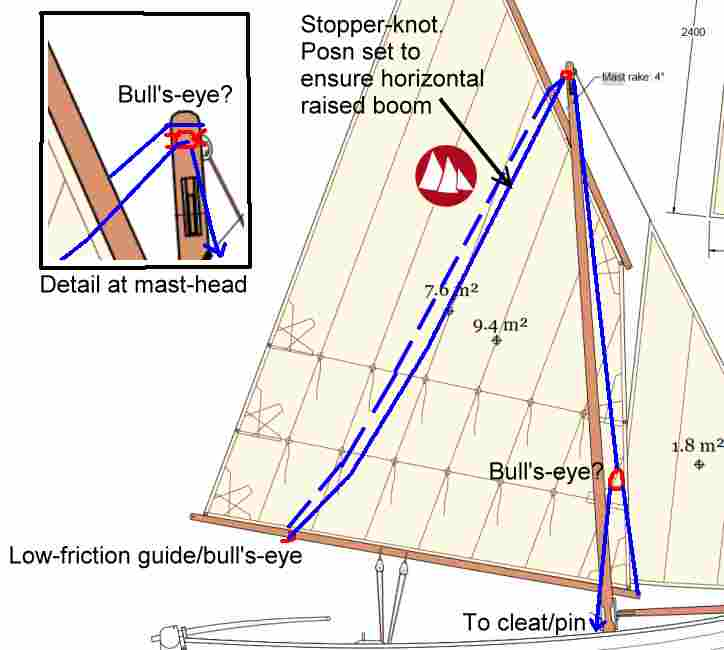
|
|
Thanks for that Paul; that’s an interesting lazy jack arrangement; (ie a halyard running to bull’s eye (block) and a purchase from the front of the boom through to a cleat. Also, there is only one point of attachment on aft of the boom, whereas most systems use two, forming a sort of inverted Y. I use lazy jacks on a Noelex 25 and the Y supports the boom whilst I drop the sails, for example coming into anchor. Michael Storer argues any small dinghy lazy jack system should to be easily released to allow boom and yard down into the boat quickly, sop that the helm can reef sitting down. Last week, reefing with the boom swinging around and the boat pitching was not ideal.
On reefing, I have put in loops as with the Goat Island Skiff and the system works well. I’m intrigued by your gib sheet arrangement. I haven’t flown the gib yet; there is quite enough power in the main alone at the moment. I have a pair of cam cleats for the jib sheets but haven’t fitted them yet. Hopefully we’ll get some wind this weekend so I can try a few more tweaks. (we’ve had a large high sitting over NZ for the last week, producing 0-5 knots most days and very cold clear skies). A couple of posts ago, you commented that the oars in one of my pictures looked a bit short. I build those out of ash for an Oughtred Auk I built a couple of years ago. I’ve almost finished a pair of 2.7 metre oars from Northern white cedar, though not with thole pins, I’ll stick with rowlocks. |
|
In reply to this post by Nigel McC
And a pair of 2.7 metre oars, ready for sanding, glassing and finishing. There are an awful lot of shavings.
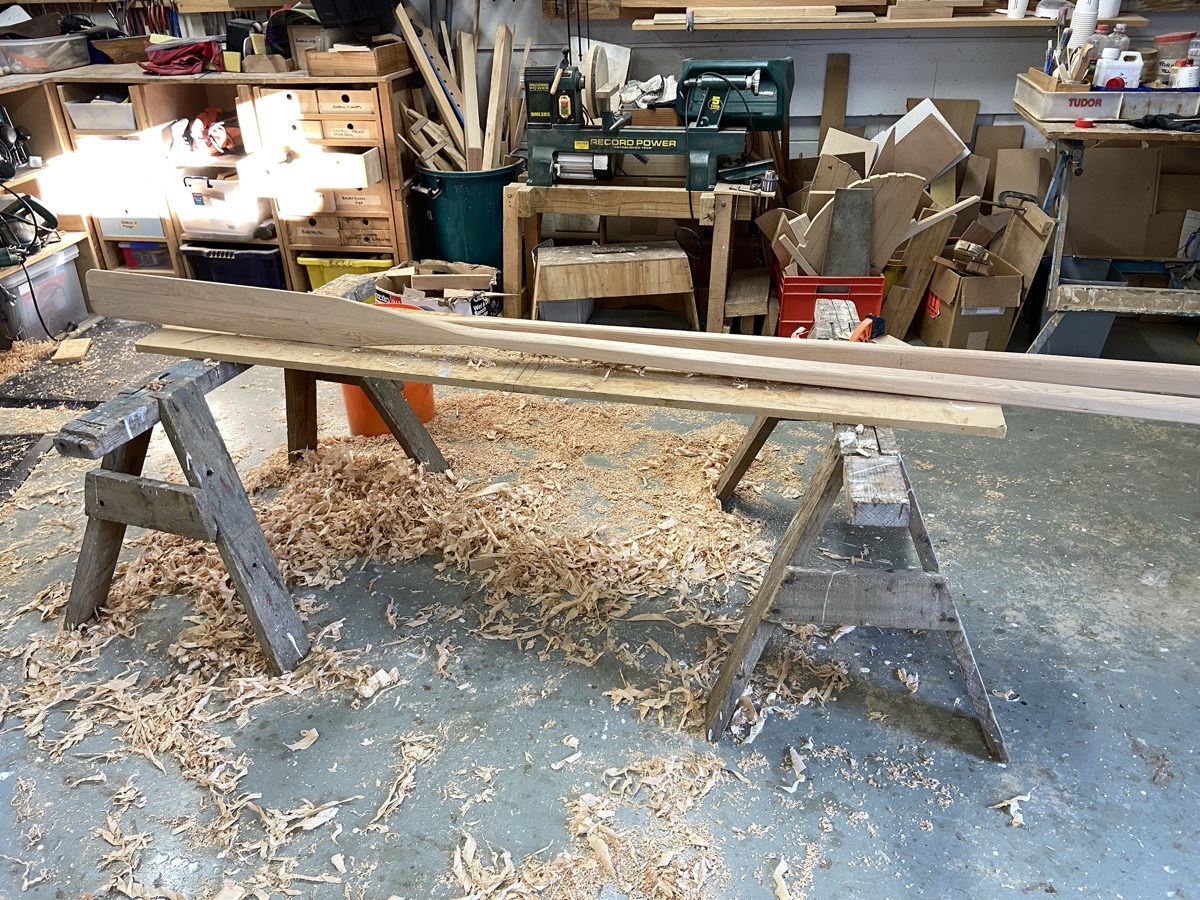
|
|
In reply to this post by Nigel McC
Here's an alternative bowsprit system to leading the spar through an iron on the stem. I could not find the bronze in Hamilton, and besides I don't really want a permanent fixture on the stem head.
So, there is a hollow Sampson post through the forward mast hole. The mast is lashed to the post (I will change the lashing rope for something neater) and the the aft end of the bowsprit fits into a mortice on the top of the post. The jib is lead through to a bobstay leading to the towing eye. 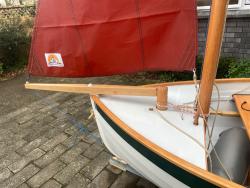 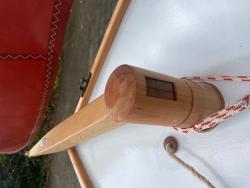 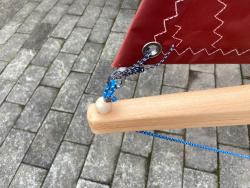 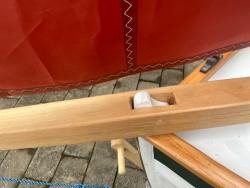 The bowsprit is laminated from a spruce sandwiching a layer of fibreglass for extra strength. The top of Sampson post as turned from Victorian Ash (a eucalypt), and the stem of the Sampson post is a birds mouth hollow spar from scrap spruce. |
«
Return to MyMorbic Sail-&-Oar Dinghy UK Network
|
1 view|%1 views
| Free forum by Nabble | Edit this page |

